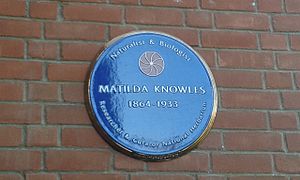Matilda Cullen Knowles facts for kids
Quick facts for kids
Matilda Cullen Knowles
|
|
|---|---|

portrait
|
|
| Born | 31 January 1864 Ballymena, Ireland
|
| Died | 27 April 1933 (aged 69) Dublin, Ireland
|
| Alma mater | Royal College of Science for Ireland |
| Known for | Formative study of Irish lichens |
| Scientific career | |
| Fields | Lichenology |
| Institutions | National Museum of Ireland |
| Influences | Robert Lloyd Praeger, Annie Lorrain Smith, Mary Leebody |
| Influenced | Maura Scannell |
| Author abbrev. (botany) | M.Knowles |
Matilda Cullen Knowles (born January 31, 1864 – died April 27, 1933) was a very important Irish scientist. She is known as the founder of modern studies about lichens in Ireland. Lichens are like tiny, colorful patches you see on rocks and trees. They are actually two living things – a fungus and an alga – growing together!
Matilda did a lot of her work in the early 1900s. From 1923, she helped look after the plant collection (called a herbarium) at the National Museum of Ireland. This collection is now kept at the National Botanic Gardens. Her studies helped us understand the plants of Ireland and Western Europe much better.
Contents
Early Life and Learning
Matilda Knowles was born in Cullybackey, near Ballymena, Ireland, in 1864. She loved plants from a young age. Her father, William James Knowles, was also interested in science and encouraged her. He would take Matilda and her sister to meetings of the Belfast Naturalists field club. This was a group where people who loved nature could meet and share what they learned.
At one of these meetings, she met Robert Lloyd Praeger. He became a very important friend and helper throughout her life. In 1895, she met another botanist, Mary Leebody. Together, they worked on a special book about the plants of North-east Ireland.
Matilda also helped gather information about plants in Tyrone County. She asked many people to send in examples of plants they found. In 1897, she published her first paper about flowering plants in Tyrone. She sent in over 500 plant examples for a big book called Irish Topographical Botany, which Praeger published in 1901.
Later, Matilda and her sister, Catherine, studied natural science at the Royal College of Science for Ireland. This was between 1896 and 1900. In 1902, Matilda started working at the National Museum of Ireland. She worked closely with Professor Thomas Johnson to build up the museum's plant collection. They also wrote a book together about Irish flowering plants and ferns.
Her Science Work
Studying Clare Island
One of Matilda's first big projects was studying the lichens on the coast of Howth. The Royal Dublin Society published her findings in 1913. She gained a lot of experience helping with a huge study of Clare Island. This study, suggested by Robert Lloyd Praeger, happened in 1910–1911. Many scientists from Ireland and Europe, including famous lichen expert Annie Lorrain Smith, took part.
This was one of the biggest field studies of its time. It helped Matilda become an expert in lichens.
Becoming a Lichen Expert
Matilda Knowles wrote more than thirty science papers between 1897 and 1933. While studying lichens in Howth, she made an interesting discovery. She found that lichens growing by the sea grow in different colored bands or zones. These zones are based on how much they are covered by the tide. You can see black, orange, and grey zones!
Her most important work was a book called The Lichens of Ireland. This book added over 100 new types of lichens to the Irish list. It also showed where all 800 known Irish lichen types could be found. Matilda worked with thirty other scientists to complete this huge task. The book was published in 1929 and included twenty lichens that had never been found in Ireland before.
Later Years
When Professor Thomas Johnson retired in 1923, Matilda took over looking after the museum's plant collection. She worked with Margaret Buchanan. As Matilda got older, her hearing became poor. She had to use an ear trumpet to hear. Even with her deafness, she still went to meetings. If she thought people had talked enough, she would put down her hearing device as a signal!
Matilda took great care of the National Museum's plant collection and added many new items. She planned to retire in 1923, but sadly, she got pneumonia and passed away before she could. Matilda Knowles died in Dublin on April 27, 1933.
How She Was Remembered
In October 2014, a special plaque was put up to honor Matilda Knowles. This was done to mark 150 years since her birth. The plaque is at the National Botanic Gardens of Ireland.
Lichens Named After Her
Several types of lichens have been named in honor of Matilda Knowles, including:
- Lecidea matildae H.Magn. (1956)
- Pestalotia matildae Richatt (1953)
- Verrucaria knowlesiae P.M.McCarthy (1988)
However, some other species like *Acarospora knowlesii and *Meliola knowltoniae were named after different people or plants, not Matilda.
See also
 In Spanish: Matilda Cullen Knowles para niños
In Spanish: Matilda Cullen Knowles para niños


